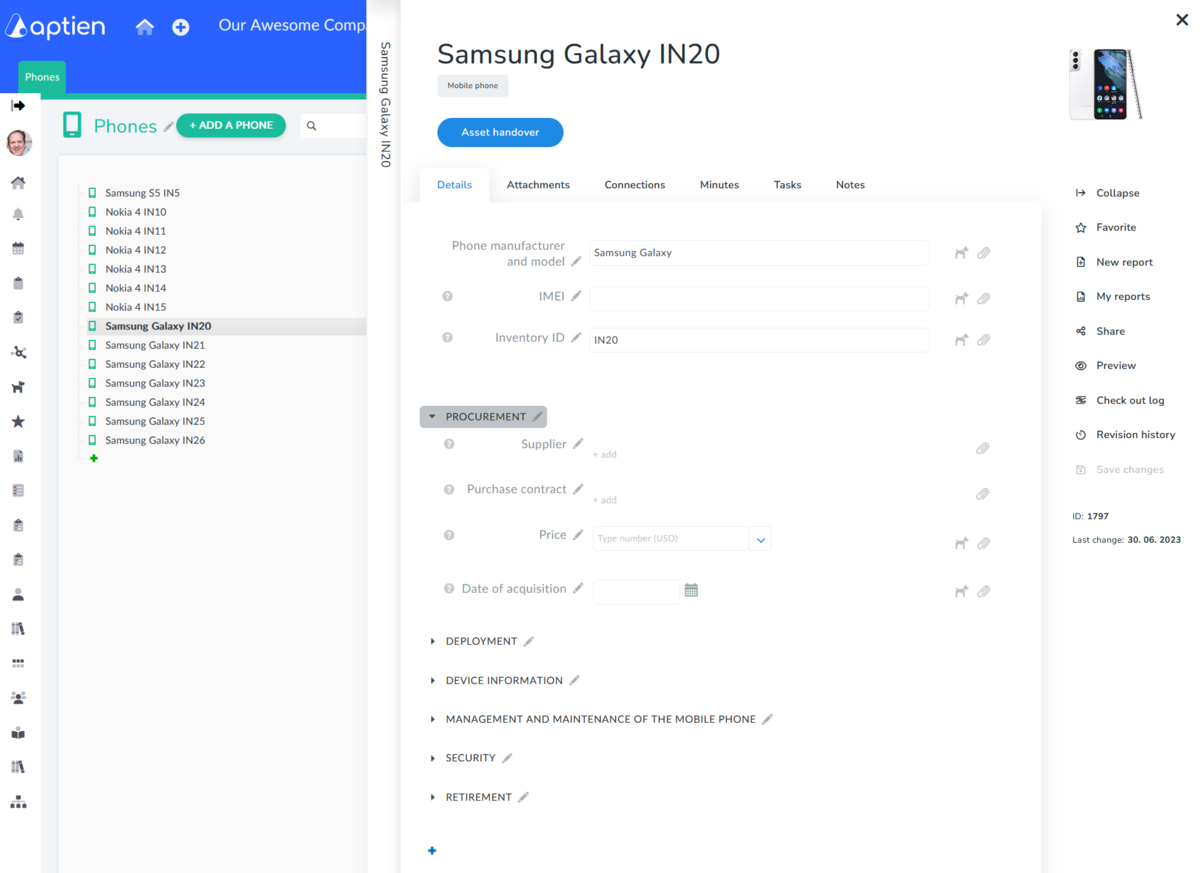What is Asset Record
Asset Record is a detailed record of an individual asset where you maintain and document all its specific information. It is part of various asset inventories where you manage specific details for each type of asset. The asset record is used to track the lifecycle, condition, and responsibility for a particular piece of asset, whether it is a physical asset (likelaptops, vehicles, machinery) or an intangible asset (like software licenses).
- An Asset Record is a fundamental component of asset management, providing a comprehensive overview of a single piece of company property.
- The information maintained on asset cards in Aptien is focused on operational management rather than accounting purposes.
- The asset card is the foundation of asset management and is accessible to the asset manager in all asset records.
Key Information in an Asset Record:
- Asset Identification: Unique ID, asset tag, or serial number
- Description: Type of asset, including its type, model, and specifications.
- Acquisition Details: Records the purchase date, cost, vendor and warranty information
- Location: Indicates the current location of the asset within the organization.
- Condition & Status: Current condition of the asset, including any wear and tear. (new, in use, under repair, retired)
- Assignment & Accountability: Assigned employee, department, or location. Tracks which employee or department is responsible for the asset.
- Maintenance Schedule: Includes planned maintenance activities, schedules, and history.
- Maintenance History: Operational log, Maintenance log, Service records, Inspections, and Updates, Service records, inspections, and updates
- Return & Disposal Info: Date of return or decommissioning details
Practical Use Cases:
- IT Equipment: Track laptops, mobile phones, and other IT assets, including their maintenance and usage history.
- Office Supplies: Manage office furniture, tools, and other supplies, ensuring they are in good condition and properly allocated.
- Vehicles: Monitor company vehicles, including their maintenance schedules and usage logs.
- Tool Tracking: Monitor tools and devices used in various departments to prevent loss and ensure availability.
- PPE Management: Manage personal protective equipment to ensure compliance with safety regulations.
Key Features of an Asset Record
- Operational Information: Contains all essential details about the asset, including its description, serial number, acquisition date, location, and current condition.
- Lifecycle Management: Tracks the asset from acquisition to disposal, including maintenance schedules, usage logs, and any operational activities.
- Documentation: Stores all relevant documents such as purchase contracts, user manuals, maintenance records, and operational logs.
- Digital Logs: Includes a digital operational log or maintenance log where all activities related to the asset are recorded.
- Usage Logs: Documents how and when the asset is used, ensuring proper utilization.
- Documentation: Stores relevant documents such as purchase receipts, user manuals, and maintenance records.
Operational documentation of the asset
In the Asset Record, you keep all the documentation for the asset
- Documentation
- Maintenance Logs
Keeping a maintenance log or operating diary
- You can also keep an operations diary or other entries and records around your assets on the assets tab.
Why Asset Records Are Important:
- Accountability: Ensures employees are responsible for assigned equipment
- Compliance: Supports audits and legal compliance (e.g., tax reporting)
- Cost Management: Tracks depreciation, maintenance costs, and replacements
- Risk Mitigation: Reduces loss, theft, or unauthorized use of company property
